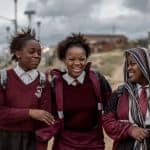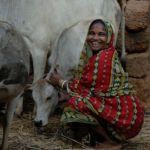Girls Empowerment Programs Are Working: Now What?
Over the last several decades, organizations dedicated to empowering disadvantaged girls have been working to address some of the social, health and economic challenges that disproportionately limit their futures. These range from child marriage and teenage pregnancy, to limited education compared to their male counterparts.
Yet although this work has made an impact, progress towards meeting the Sustainable Development Goals for women and girls “remains unacceptably slow,” according to a U.N. report. It is clear that more needs to be done — but where should development initiatives focus?
Last Monday, leaders and researchers in the international development space convened at Evidence to Action: The Future of Work for Deprived Youth to map out the existing research on youth employment programs and outline an agenda for the future. They looked specifically at empowerment programs for adolescent girls, and explored the findings from three robust research evaluations to assess what is working to economically and socially improve their lives.
The discussion revealed several keys to successful programs – along with the challenges involved in applying these successes across cultures.
Key Elements of Successful Programs
The evidence shows that many of the basic elements making up a successful girls empowerment program are similar, and nearly across the board, programs that bundle multiple elements are helping girls improve their health and incomes. These programs often have some combination of a few elements, which may look slightly different from program to program, as they are designed for the local context. But broadly speaking, they include:
- Life skills, such as sexual and reproductive health, decision-making and gender rights, provided in a safe space;
- Livelihoods promotion, like skills development, vocational training or entrepreneurship training;
- Financial support, often in the form of financial literacy training and microloans.
One example of this approach is BRAC’s Empowerment and Livelihoods for Adolescents (ELA) program, which incorporates life skills, livelihoods training and financial support in a safe space for girls. A randomized control trial (RCT) in Uganda revealed striking economic empowerment outcomes as a result of the program. Four years after the program, girls who participated were 48 percent more likely to engage in income-generating activities, an impact mainly due to increased levels of self-employment. These results are particularly significant in light of a recent review of labor market policies that found these approaches to supporting job-seekers (with vocational training, job search assistance, etc.) only raised employment by two to three percentage points on average.
And not only did ELA improve income, it improved social empowerment outcomes like family planning, fertility and safe sex. Reports of forced sex and rates of teen pregnancy and early marriage among participating girls also dropped dramatically.
A slew of similarly structured – and often similarly effective – girls empowerment programs have sprouted up across the globe. For example, the Bangladeshi Association for Life Skills, Income, and Knowledge for Adolescents offers “BALIKA clubs” in rural Bangladesh, which are girls empowerment clubs that incorporate a life skills curriculum into a safe space format. An RCT from Population Council analyzed three different strains of BALIKA clubs, each of which included an additional feature in conjunction with the core model. These features included: tutoring in English and math or financial literacy; education on gender rights, with a focus on sexual and reproductive health, negotiation, decision-making and gender-based violence; and livelihoods training in basic health screening, computers, entrepreneurship and photography.
The RCT found that all three strains of the BALIKA clubs led to social empowerment, including improvements in educational attainment, attitudes towards gender, instances of child marriage, and knowledge of health and family planning. The gender rights and livelihoods models also facilitated economic empowerment: Girls who participated were significantly more likely to earn an income than their peers who had not participated.
Also in Bangladesh, a third RCT evaluated Save the Children’s Kishoree Kontha clubs, safe spaces for girls that incorporate training in life skills like social competencies, nutrition, reproductive health, role-playing and negotiation; education support including tutoring on literacy, numeracy and oral communication; and training in financial literacy, saving and entrepreneurship.
Girls in Kishoree Kontha clubs were six percent more likely to be in school, and stayed in school an average of 6.2 months longer. They experienced improved physical, mental and reproductive health, had healthier attitudes towards gender and felt more empowered to make health-related decisions. They were also eight percent more likely to be employed and 31 percent more likely to be formally employed.
It’s clear these bundled program models can be deeply impactful by offering training in life skills, livelihoods and financial services and presenting it in a safe space. But despite these successes, we need to better understand how to adapt these approaches to varying contexts – and BRAC’s ELA program provides a compelling rationale.
The Downside of Duplication
After ELA proved wildly successful in Uganda, BRAC decided to bring the model back to Bangladesh. The organization has operated there for over four decades, and has developed a deep knowledge of the cultural context, along with extensive familiarity with communities in nearly every corner of the country.
But the same model that had been so impactful in Uganda failed in Bangladesh.
In Uganda, girls often lack the requisite skills and capital they need to generate a stable income. The ELA clubs are effective largely because they offer training and financial services that remove these technical barriers to economic empowerment.
In contrast, BRAC found that social norms were much more likely to constrain girls in Bangladesh. Many program participants had limited power over the financials in their household. As a result, Bangladeshi girls in ELA clubs often could not take advantage of the training and financial services that the clubs offered, and did not experience economic empowerment outcomes.
Although the ELA program in Bangladesh incorporated the same basic components of life skills, livelihoods training and financial empowerment, the differing cultural landscape prevented girls from reaping the same outcomes as their counterparts in Uganda.
A retrospective on the pilot, published in Stanford Social Innovation Review, explains, “Though poverty may look similar in new environments, development professionals must first disentangle what is different before applying lessons from past successes.” Social and economic empowerment are determined by a complex web of factors that may vary greatly from one context to another. In addition, the relational barriers in a certain context — in this instance, family and social dynamics — are challenging to change.
Now What?
Now that researchers and practitioners have a good idea of what is working to empower girls, the focus should be on identifying which combinations of services work where and why, and building a robust body of evidence to support it. This will help provide implementers with the tools they need to adapt these existing bundled approaches to new contexts, scale them up and ensure that the same successful outcomes are achieved for girls everywhere.
Sarah Allen is a Communications Associate at BRAC USA.
Image courtesy of author.
- Categories
- Impact Assessment



